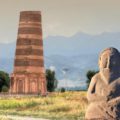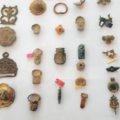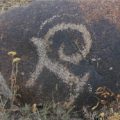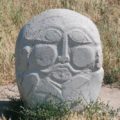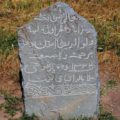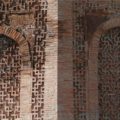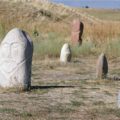- Археологические находки, VII–XII века
- Петроглифы, I век до н. э.
- Древнетюркские балбалы
- Мусульманское надгробие, XIV век
- Узорные стены Башни Бурана
- Древнетюркские балбалы
Many centuries ago, the great city of Balasagun sat on a caravan road that connected China, India, Central Asia, the Middle East, and Europe. The capital of the Karakhanid Empire, Balasagun was inhabited throughout the 10–14th centuries. Today, the ancient city is located in the Chuy valley of modern-day Kyrgyzstan, near Tokmak city.
In 940, the Karakhanids, the first Turkic dynasty officially converted to Islam, conquered Balasagun, which became the capital of their state (along with Kashgar). After the division into the Eastern and Western Khaganates in 1041–1042, it remained the main city of the eastern part of the empire. From the 1130s to early 13th century it was the capital of the Western Liao (Kara-Khitan, Kara-Kitai), and from 1211 to 1218 of the Naimans. Under the Mongols, at the beginning of the 13th century, the city was named Gobalyk and existed until the 14th century.
Balasagun is a vivid example of the development of a Muslim city in the northeastern part of Central Asia in Middle Ages. Archaeological data discovered in its territory along with written sources reflect dramatic changes that occurred after Islam took a monopoly position in the region as to the way of life, funeral rituals, the widespread use of the Arabic language and writing, the development of monumental architecture closely linked with this religion, the predominance of ornamentalism in the visual arts and much more.
Beside islamic artifacts unearthed in the territory of historical buildings there are also artifacts associated with Buddhism and Syro-Nestorianism. Graves of both Muslims and Nestorian Christians have been discovered on the site, which testifies to intercultural and interreligious life, as well as to tolerance including religious. Tombstones with epitaphs in honor of fakikhs (theologians and law scholars), muftis, imams and other religious leaders were found alongside commoner graves. Dates in the kairaks are designated according to both the Islamic and the traditional Turkic calendars. Stones with epitaphs in the Syriac language depicting a cross were found in Christian cemeteries.
A medieval megapolis
The many remaining brick foundations of houses, market squares, various buildings indicate that Balasagun was a very large and developed city. According to historical documents, about 16 thousand inhabitants lived in Balasagun about 30 sq km in size. It was a metropolis for its time. Life was in full swing here, new caravans came after the others. The passage of caravans packed with foreign goods is confirmed by the findings of all kinds of coins, jewelry, ceramics and other items oftentimes of European origin. The city was flourishing and became one of the richest in Central Asia.
Since Balasagun was formed in different historical and cultural conditions than the rest of the medieval settlements of the Chui valley it does not have a citadel, and its shakhristan is relatively small, but the inner area is very impressive in size. The central part of the city has the shape of a quadrangle 570×500×600×570 m in dimension. Four meters of tower have survived. The outskirts was surrounded by two concentric rings of ramparts, the outer of which reached 17–20 km in length.
Balasagun is often mentioned in written sources pertaining to important studies carried out there in culture, art, science, mathematics, astronomy and philosophy. It was also known for his descendants such as Yusuf Balasaguni, the poet and the founder of Turkic fiction, who wrote his first work in the Turkic language. It was the Kutadgu Bilig poem meaning Graceful knowledge.
A legendary tower
Time had not spared the city, turning most of the buildings into ruins, but its main attraction has survived. It is the pompous and majestic Burana Tower. It was the minaret of the Jami Mosque and is considered one of the first structures of a this kind in Central Asia. Minarets were usually built into or adjacent to mosques and were intended to call believers to prayer. Historians and archaeologists believe that the mosque used to be located on the western side of the tower. Like majority of minarets, the Burana tower was crowned with an onion-shape top, which had four doorways facing the cardinal directions.
This architectural monument is unique, because it is the only building of this type that has survived to this day since the late 10th — early 11th centuries. Its authenticity has been confirmed by many studies, in particular, by the architectural layout, artistic, decorative and building techniques typical for similar structures of that time, as well as archaeological materials discovered both near the tower and in other places of the old settlement.
The tower, that used to be 45 meters heigh, had been damaged during earthquakes and was restored to its original appearance in the 1970s. Today its height is 21.7 meters which is 70 percent of the original structure. It was used by the Karakhanids both as a minaret and as a watchtower. At the top there was always a designated person who showed the way to distant caravans with a lantern so that they would not get lost on the way.
The tower, built of baked bricks, has the shape of a cylinder tapering towards the top and with a spiral staircase inside. The foundation, made of a stones with clay mortar, is faced with marble. Above the foundation there is a podium, on which a plinth made of baked bricks of an octagonal configuration is pulled over. The outer walls are finished with decorative bricks. The inner space of the tower is lit through two windows. A wonderful view opens up from its top. There is an unknown tomb inside the tower. In addition, the tower stores historical artifacts and handicraft pieces discovered in the area.
Near the tower there is a “rock garden” — a small collection of balbals (ancient stone sculptures) or Kurgan steles. These small stone figures were used to honor the dead and sometimes marked burial places, old tombstones, millstones and rocks with carvings dating back to 1st century BC. Balbals are made of specially selected elongated stones shaped into human figures. The overwhelming majority are shaped as men of Mongoloid appearance, with a mustache and beard, sometimes with braided hairstyle. A goblet was often carved in the right hand, the left hand rested on the hilt of a sword or dagger suspended from the belt. Some of the most elaborate sculptures show clothing, headdresses, earrings, bracelets, necklaces and other adornments of that time.
There are many legends about the Burana tower shrouded in an aura of sadness and mystery. The most famous legend tells of a khan who had a daughter worthy of all praise. Her beauty and intelligence won the love of the people, and, it would seem, the girl was destined for happiness and a peaceful life. Once a fortuneteller told her that she would die a terrible death from the bite of a karakurt (black spider) that was found in this area at that time. Fearing for his daughter’s life, the khan decided to build a tower that would save her from a terrible prediction. The beauty lived at its very top, and each visitor was carefully checked. However one can’t escape one’s fate. On her 16th birthday, the khan by chance brought her a karakurt in grape leaves. The poisonous bite killed the young girl. Distraught with grief, the khan hit the tower wall with his fist and knocked down several upper brick rows. Since then, the structure has remained dilapidated.
Materials provided by the National Commission of the Kyrgyz Republic for UNESCO

